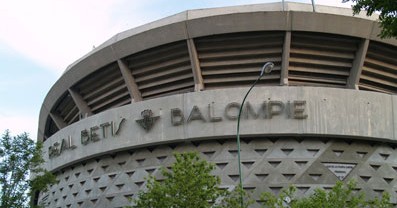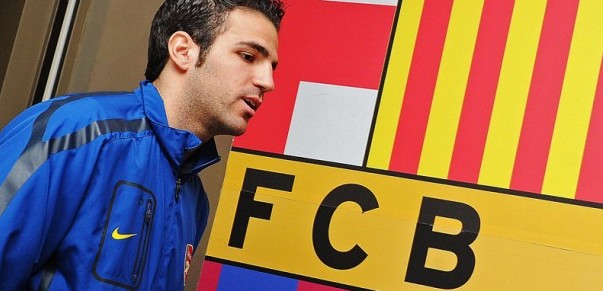- S.D. Eibar ready for maiden La Liga outing
- SD Eibar stengthen ahead of debut La Liga season
- Can ‘Super Mario’ live up to expectations in Madrid?
- MAN IN THE GROUND – Brentford 0 – 4 Osasuna
- Historic Basque derby welcomes S.D. Eibar to La Liga
- Munich to Madrid, via Brazil – Tony Kroos
- Rakitic in Spanish Switch
- Can Spain find redemption in Rio?
- Viva Espana! A season of redemption for Spanish football
- From the old to the new: who can fill the void in years to come for La Roja?
Estadio Benito Villamarín – Home of Real Betis Balompié
- Updated: 25 September, 2011

This week, stadium expert Chris Clements brings us a history of the season’s surprise package, Real Betis Balompie.You can read more on the football stadiums of Spain at the wonderful http://estadiosdeespana.blogspot.com.
We hope you enjoy this week’s offering and, as always, thanks for your fantastic article Chris!
Sevilla is all about heat and passion. It’s officiallyEurope’s hottest city and the home of flamenco & Carmen.
Also, a couple of times each year the temperature and desire shoot off the scale as Sevilla Fútbol Club and Real Betis Balompié lock horns.
Further spice is added to the concoction when you learn that Betis emerged into this world when discontented members of the then fledgling Sevilla FC, left to form their own club in 1908.
This club, Betis FC then joined forces with Sevilla Balompié and thanks to a spot of royal patronage, became Real Betis Balompié.
The club continued to use Betis FC’s stadium, the Campo del Prado de San Sebastián, but in 1918 moved to Campo del Patronato Obrero.
This ground was developed over the next ten years and by 1928, had a capacity of 9,000. In 1929 a new stadium in the Heliopolisdistrict of the city was opened.
With an 18,000 capacity, this square sided arena was ideally suited to the up and coming Betis, but the club continued to use Patronato until the end of the 1935-36 season, by which time they had won their first and only La Liga title in 1934-35.
Despite winning the league title, finances at the club were in a poor state and in 1936 the club reached an agreement with the Municipality to effectively swap Heliopoliswith Patronato.
The timing of the agreement could not have come at a worse time. Signed on 16 July 1936, the Spanish Civil War began 24 hours later.
The club offices were bombed, most of the staff fled abroad and membership dropped below a hundred.
Peace arrived in the spring of 1939 and Betis finally had a chance to useHeliopolis. Betis however, was a club in decline and by 1946-47, just nine seasons after winning La Liga, the unthinkable happened as Betis dropped to the Tercera.
It took fifteen long years for Betis to get back to La Primera and the stadium, now approaching 30 years of age needed a refit.
The original shallow side terraces were re-pointed and the north and south ends were replaced with more substantial structures.
Betis looked reasonably comfortable on their return to La Primera and a series of top half finished was capped in the 1963-64 season with a third place finish.
By thenHeliopolishad been purchased outright and renamed Estadio Benito Villamarin in honour of the chairman. The summer of 1966 however, saw the twin blows of relegation and the death of Benito Villamarin, who succumbed to cancer at the age of 49.
Over the next eight seasons, Betis switched between La Primera and La Segunda on five occasions and that air of change was matched off the pitch as well. Between 1971-73 the terraces at the north and south ends were upgraded and the corners filled in.
1975 saw the addition of a daring upper tier on the west side, with banks of green and white seats and a slender green cantilevered roof. Building continued and in 1979 the east side was demolished and a new Tribuna was constructed.
A second tier and propped roof was added in 1981, before an amphitheatre was built between the upper and lower tiers of the west stand in 1982. As well as additional seating, this housed new media facilities which were used when the stadium hosted two World Cup matches in 1982.
The stadium remained unchanged for the next 16 years, but Betis continued to flit between the top two divisions, then in 1992, enter stage right Manuel Ruiz de Lopera, who took over ownership of the club. Initially, things appeared to be rosy in the garden.
Top flight status was regained and the Copa del Rey was won in 1997. Lopera convinced the board that the stadium should be rebuilt and bear his name.
Work started in April 1998 and would consist of three tiers on all four sides of the ground, set off with a roof, but to start with, the north and east sides would be built.
The first tier was complete in September 1998, with the other two tiers opening in late 1999. Whilst all this was going on off the pitch, Betis’ fortunes on it were plummeting and at the end of the 1999-00 season, Betis took their 52,000 capacity stadium back to La Segunda.
In reality, Betis was borrowing heavily to develop the stadium and with reduced income work on the stadium ground to a halt.
Ten years after work ceased, Betis fans voted in October 2010 to return the stadium to its former name.
The Estadio Benito Villarmarin is essentially three stadiums joined together; rather unconvincingly it has to be said.
Many stadiums, particularly inEngland, have been developed on a piecemeal basis, that is to say stand by stand, but do any create such a stark contrast as the Estadio Benito Viamarin?
Individually, the stands are fine, especially the exterior detail which reflect Sevilla’s Moorish past, but when joined together you have a stadium with a touch of the Dr Victor Frankenstein’s.
I would quickly add however, that this does not detract from the incredibly intense atmosphere the Betis fans generate, helped in no small part by tall amphitheatres on three sides of the ground.
The current stadium set up however, is not one of my favourites.
The 1980’s version with its balanced symmetry and its broad bands of green and white seats was more to my liking, but nothing lasts forever in this world, particularly it would appear, Betis’ top fight status.
Follow @icentrocampista










One Comment
You must be logged in to post a comment Login